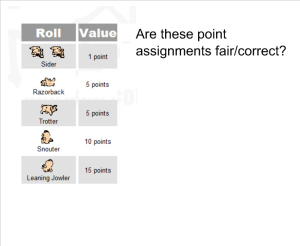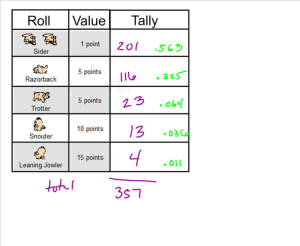| I’ve been trying to come up with a way to immerse my students in the law of large numbers without simply giving them the law and reading example after example. To jog your memory, the law of large numbers states: as the sample size increases, the experimental probability will approach the theoretical probability…or as one of my students stated, as the sample size gets larger, the prediction (experimental probability) gets more accurate. |
 |
| I’ve been playing Pass the Pigs for a long time, and I’ve always wondered about the probability of having the pigs land in the different piggy positions. (If you don’t know what I’m talking about, go here: http://passpigs.tripod.com/rules.html). |
| So, I asked them this question: |
 |
| I explained to my students that we were going to modify the game to just look at rolling one pig. The conversation started with my students deciding that the higher the point value, the harder that type of roll is to get. someone eventually made the connection that the difficulty of the roll is inversely related to its probability. I then asked them what the probabilities for the different rolls were. They didn’t know,but were willing to roll some pigs to make some predictions . After some rolls, we gathered the class’s data and calculated experimental probabilities: |
 |
|
| Tons of great conversation followed. They argued about fairness and attempted to come up with a point system that was “fair.” After a few minutes, I brought them back to see what they were doing. I pointed out that they were using those experimental probabilities as if they were the absolute truth. A student quickly quipped: “but we did a lot of rolls, it should be pretty accurate.” |
| Then, and only then, we discussed the law of large numbers. |


